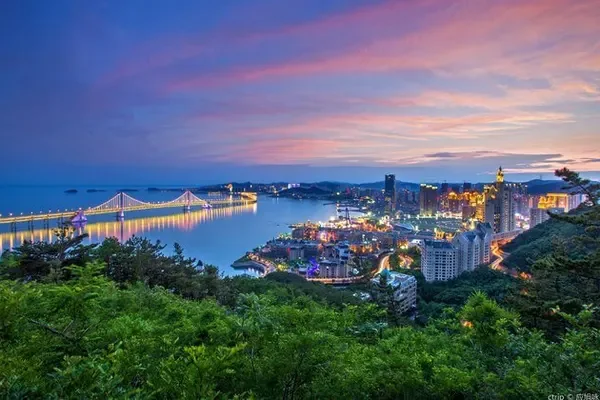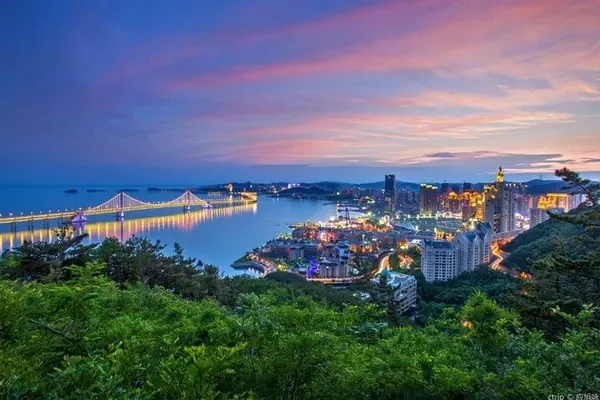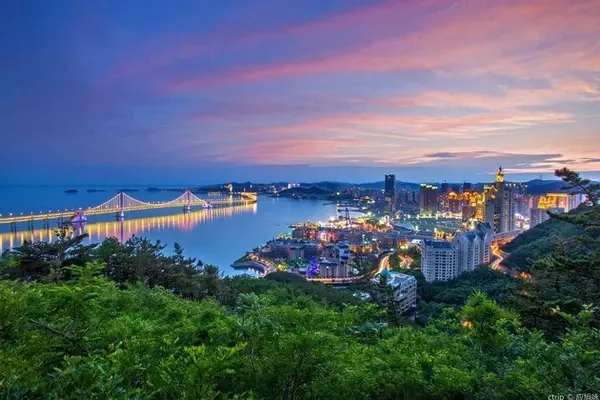The brilliant Populus euphratica forest in autumn is shining with attractive brilliance, but its best viewing period is only more than 20 days, so I never expect to witness the splendor with my own eyes. However, this year I have time to spare. I read the online introduction that around October 25 every year is the best viewing period for Populus euphratica in southern Xinjiang, so I set off from Shenzhen in early September, planning to take National Highway 317 and 219, and take a big circle to see it.
It is exciting to be able to set foot on the plateau road with the highest altitude and the most dangerous road in the world.
The entire itinerary took more than 50 days, and the general plan is as follows:
1. From Shenzhen to Longsheng, Guangxi, via Anyue, Sichuan to Rilong Town of Siguniang Mountain
2. Take the Sichuan-Tibet Northern Line (National Highway 317) all the way west, and enter Tibet via Ganzi and Dege
3. Go to Qamdo and Dingqing to Suo County, meet at Nagqu and Qinghai-Tibet Line (National Highway 109) and arrive at Shigatse
4. Take the Xinzang Line (National Highway 219) and continue westward, passing through Saga and Pulan to Zhada
5. Continue to National Highway 219 to Yecheng, Xinjiang, turn around in Shufu County and go south to Ta County
6. From Ta County to Kashgar, via Wensu and Kuqa to Tesk
7. From Yining to Nileke and Gongnais, via Hejing to Korla
8. Cross the Tarim Desert in Luntai to Ruoqiang, take National Highway 315 and leave Xinjiang to Qinghai Mangya
9. Golmud via Huashi Gorge, to Banma and out of Qinghai
10. Go to Seda, Sichuan, visit Xinlong and Litang, and go out of Sichuan in Xiangcheng
11. Take National Highway 214 to Shangri-La, Yunnan, and go to Jianchuan via Tiger Leaping Gorge
12. From Chuxiong to Anlong, Guizhou and back to Guangdong
Day 1 Shenzhen to Longsheng
After sorting out a carload of supplies, we set off from Shenzhen early in the morning and arrived in Longsheng, Guangxi at 2 pm. After checking into the hotel, we rushed to Ping'an Village in Longji Scenic Area. The terraced fields are undulating, and the seedlings grow vigorously, making it a leisurely green. It's a pity that the drone was accidentally loaded into the terraced fields. Although it took a while to retrieve it successfully, it was already dark. The first day of the journey ended in a hurry, and I went back to the hotel to order chicken soup to calm my shock.



The next day Longsheng to Zunyi
The city of Zunyi was built around the site of the Zunyi Conference. There are huge crowds of people in front of the scenic spot, many of whom are wearing PLA uniforms, as if they were in Hengdian. What's amazing is that the high walls around the scenic area are airtight, and no information about the venue can be seen. The managers' thinking is still relatively solidified.

Day 3 Zunyi to Anyue, Sichuan
Pilu Cave in Shiyang Town, Anyue County is famous for its "Shuiyue Guanyin". This trip specially arranges to visit it. The grotto was excavated in the Song Dynasty, and at the gate of the scenic spot is the picture of Liu Benzun's ten exercises, which is well preserved with both pictures and texts.

Shuiyue Guanyin sits in a protruding and steep rock cave, with elegant and beautiful dresses.

Day 4 Anyue to Rilong Town
All the way to the Inn in Rilong Town, the courtyard at the entrance is full of succulents.

It was a little rainy in the afternoon, so I walked around the mountains and looked at the village.

Day 5 Siguniang Mountain
Siguniang Mountain Changpinggou can take a traffic bus, and then walk down one by one, it is not tiring. It's just that the weather is bad, so I have some regrets. I think I will come again next time, and I can go to Shuangqiaogou and Haizigou at that time.





Day 6 Rilong to Malkang
Maerkang is the capital of Aba Prefecture in Sichuan. The weather is fine in the afternoon, so go to see Changlie Temple. Changlie Tibetan means "retreat", and it is really hidden on the high Changlie Mountain, with a vertical height of more than 900 meters. The mountain road is steep and difficult, starting from the bottom of the valley with twists and turns, climbing back and forth like a comb.

On the road close to the temple, there is a Mani wall, which was gradually formed after believers hammered and chiseled scriptures on the stone, and then built them up piece by piece.

The temple is still under construction, but the main hall has shown extraordinary momentum.




There was a sudden heavy rain, and within a few minutes of hiding in the temple, the weather cleared up and a rainbow appeared.

By the time we left, the monastery puppies had become friends.

Day 7: Malkang to Luhuo
Take National Highway 317, shortly after exiting Malkang, you can see 2 watchtowers on the roadside, called Zhibo Watchtowers, which were built in the early Qing Dynasty and are national key cultural relics protection units.

The Luhuo area has the most beautiful Tibetan-style buildings in Tibetan areas, with neat shapes and bright colors.

The sculpture in Hall Square should be the landmark building of Luhuo

Along the never-ending turning corridor, you can take us to Shouling Temple



The platform in front of the gate of Shouling Temple can overlook the whole Luhuo Town

Tibetan residences close to temples are either rich or expensive.

Day 8 Luhuo to Dege
Casa Lake is just beside National Highway 317, with clear water and mountains.



This is a plateau freshwater lake. Every day, many local Tibetans feed a box of instant noodles or a bag of steamed buns while chanting sutras. Under their care, the lake is full of fish


Manigange Zang means "the place where Mani stones are carved". This small town has only one main street, and the houses are also magnificent, but at noon, there are not many people on the street, probably the taste of the legendary Midwestern style.


Passing by the glacier viewing platform, you can see Queer Mountain at an altitude of 6168 meters

After crossing the Queer Mountain, the "Xinluhai" is in front of you. This is the highest and largest glacier lake in Sichuan. It's a pity that the scenic spot is closed. The staff saw that we came all the way but couldn't enter the scenic spot, and told us that there is a best viewing spot near the canteen on the mountain, and I was comforted in my heart. The water of the lake is as clear as jade, surrounded by forests and grasslands, and a stream winds its way, gently beating the stones with scriptures.



Temples and stone carvings along the road





Dege is the last town in the Sichuan section of National Highway 317. The Dege Sutra Printing House is the largest existing Sutra Printing House and the first of the three major Sutra Printing Houses in Tibetan areas (the other two are the Potala Palace and the Labrang Monastery).

Walking up the mountain along the plank road, there are magnificent white pagodas and exquisite Mani stones along the way.


After passing Gengqing Temple, you can see the dense red wooden houses on the hillside, which are the residences of monks.


Then go back to the square along the mountain path, find a step to sit under the sunset, quietly watch the Tibetans praying without stopping, and really feel the power of the Buddha.


New style Tibetan residence next to the monastery

Dege County is built on a long and narrow river valley, and the streets are not wide. What's interesting is that there are even arcades, which are exquisitely crafted and have Tibetan characteristics.

Dinner is at a Tibetan restaurant. The boss and his wife are both Tibetans. They don’t speak Mandarin. Their beautiful daughter is in the second grade. She is doing math homework with a computer on the side. .

Day 9 Dege to Qamdo
Qamdo means "Water Confluence" in Tibetan

There is one of the largest temples in Tibet: Jambaling Temple. There were Buddhist activities on the day we arrived, and a large number of monks were resting and chatting outside the main hall. At the beginning of the lecture, the monks took off their shoes and entered the main hall. There are many boots of the same style outside the hall. It seems that they wear shoes regardless of you and me.



After a while, the monks poured in again with the porridge bucket, and came out with an empty bucket in ten minutes, barefoot and happy all the time.



Day 10 Qamdo to Dingqing
On the way to Dingqing, it is a landscape avenue, where Tibetan residences and temples made us stop several times to appreciate them.





The yard is full of freshly harvested barley

Arrive at Zizhu Mountain in the afternoon. To go to Zizhu Temple, you must cross a 12-kilometer Z-shaped mountain dirt road, and the altitude rises from 3500 meters to 4450 meters. The temperature on the top of the mountain dropped sharply, the wind was bitterly cold, and the mountain was full of strange rocks, creating a pure and ferocious atmosphere for practicing Dharma.




Day 11 Dingqing via Baqing to Suo County
From Ding Qing to Ba Qing



Passing by Chongcang Temple, the old man at the gate of the temple has a strong desire to talk. He only speaks Tibetan and cannot understand Mandarin. It took a long time to understand that he wanted to buy our short-sighted glasses. The first time you enter Tibet, you must bring a few more pairs of reading glasses.



After arriving in Suo County, you can see the Zandan Temple, which looks like the Potala Palace, from a distance. The temple is built on the mountain and can only be reached along the long walkway. It is majestic and magnificent.


this chair is thought provoking

Flying the drone to feel it, attracted the monks to drive curiously, after a happy group photo, he must show us the treasures of the temple, unlock and close the locks all the way, and visited many hidden temples.


After Yiyi bid farewell, seeing the sky was still early, I drove to see the plateau meadow, and suddenly the wind and clouds rose again on the road, and the rainbow reappeared on the top of the mountain.

Day 12 Suo County to Dangxiong
Passing through the Nagqu Grassland



Thirteenth day: Damxiong to Shigatse
Leaving Dangxiong and arriving at Kuoqionggangri Glacier, the gate of the scenic spot is a bit crude. After buying a ticket and entering the park, you can drive more than ten kilometers to see the glacier at close range. The scenic spot is still making a plank road up the mountain, but the glacier has receded significantly.








When I went in, I thought about the glacier, completely ignoring the beautiful scenery on both sides of the road, and when I came out, I made up for it all.



Entering the Shigatse area, you can see the gentle valley plains and the large barley fields beside the road. It is the harvest season, and there is a golden ocean under the breeze.

goodbye
When you arrive in Shigatse, you will start the very tempting Xinzang Line (219 National Highway) itinerary. See you in the next section!



